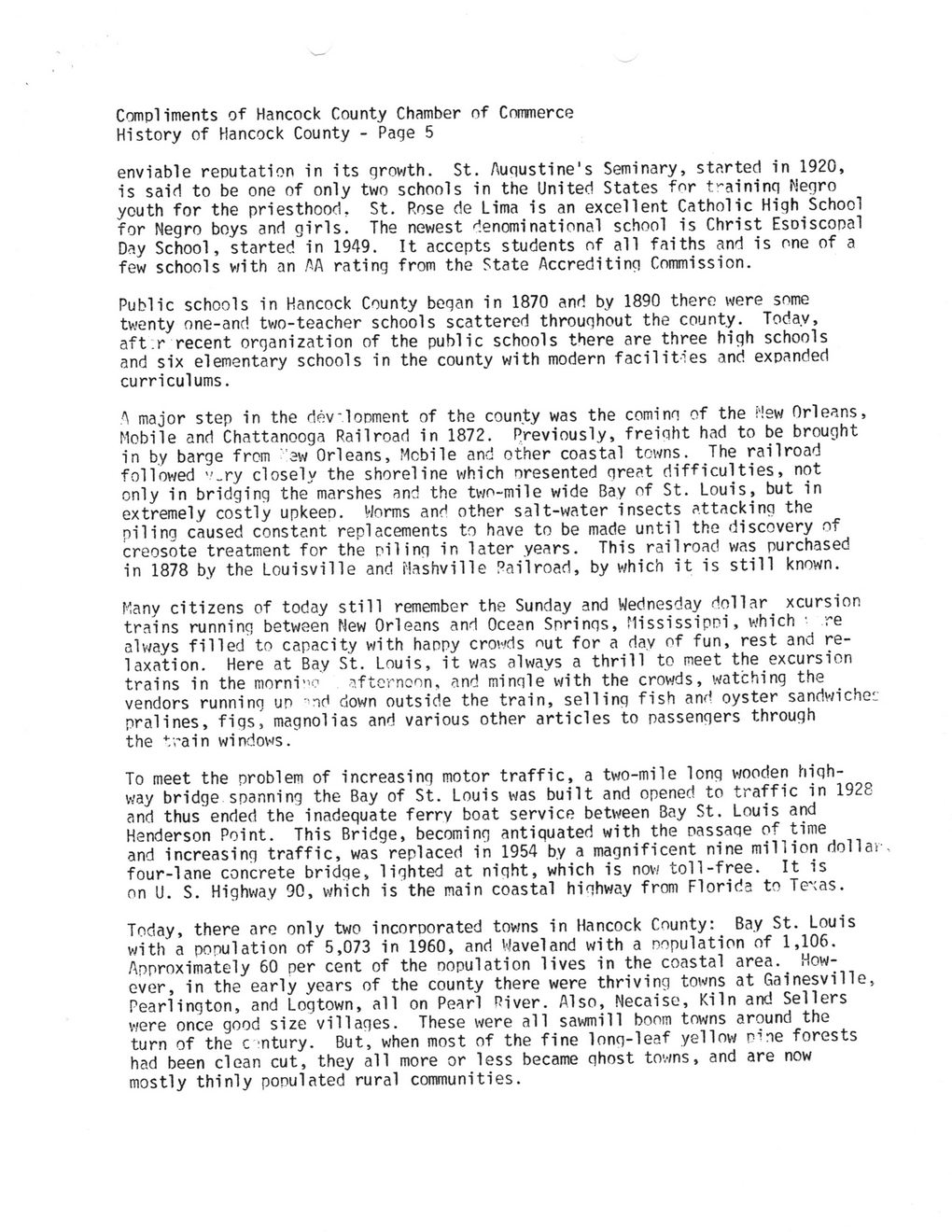This text was obtained via automated optical character recognition.
It has not been edited and may therefore contain several errors.
Compliments of Hancock County Chamber of Comierce History of Hancock County - Page 5 enviable reputation in its growth. St. Auqustine's Seminary, started in 1920, is said to be one of only two schools in the United States for t^aininq Negro youth for the priesthood. St. Rose de Lima is an excellent Catholic High School for Negro boys and girls. The newest denominational school is Christ Esoiscopal Day School, started in 1949. It accepts students of all faiths and is one of a few schools with an M rating from the State Accrediting Commission. Public schools in Hancock County began in 1870 and by 1890 there were some twenty one-and two-teacher schools scattered throughout the county. Today, aft.r recent organization of the public schools there are three high schools and six elementary schools in the county with modern facilities and expanded curriculums. A major step in the devlopment of the county was the cominn of the New Orleans, Mobile and Chattanooga Railroad in 1872. Previously, freiqht had to be brought in by barge from "aw Orleans, Mobile and other coastal towns. The railroad followed v'„ry closely the shoreline which oresented qreat difficulties, not only in bridging the marshes and the two-mile wide Bay of St. Louis, but in extremely costly upkeep. Worms and other salt-water insects attacking the piling caused constant replacements to have to be made until the discovery of creosote treatment for the oiling in later years. This railroad was purchased in 1878 by the Louisville and Nashville Pailroad, by which it is still known. Many citizens of today still remember the Sunday and Wednesday dollar xcursion trains running between New Orleans and Ocean Snrinqs, Mississippi, which ■ re always filled to capacity with happy crowds nut for a da.v of fun, rest and relaxation. Here at Bay St. Louis, it was always a thrill to meet the excursion trains in the morni'io afternoon, and minqle with the crowds, watching the vendors running up 'nd down outside the train, selling fish and oyster sandwiches pralines, fiqs, magnolias and various other articles to passengers through the Vrain windows. To meet the problem of increasing motor traffic, a two-mile long wooden highway bridge spanning the Bay of St. Louis was built and opened to traffic in 1928 and thus ended the inadequate ferry boat service between Bay St. Louis and Henderson Point. This Bridge, becoming antiquated with the oassaqe of time and increasing traffic, was replaced in 1954 by a magnificent nine million dollar, four-lane concrete bridge, lighted at niqht, which is now toll-free. It is on U. S. Highway 90, which is the main coastal hinhway from Florida to Te\as. Today, there are only two incorporated towns in Hancock County: Bay St. Louis with a population of 5,073 in 1960, and Waveland with a population of 1,106. Approximately 60 per cent of the population lives in the coastal area. However, in the early years of the county there were thriving towns at Gainesville, Pearlington, and Loqtown, all on Pearl ^iver. Also, Necaise, Kiln and Sellers were once good size villages. These were all sawmill boom towns around the turn of the century. But, when most of the fine lonq-leaf yellow pine forests had been clean cut, they all more or less became qhost towns, and are now mostly thinly populated rural communities.

Hancock County History General History-of-Hancock-County-(05)